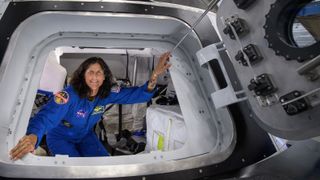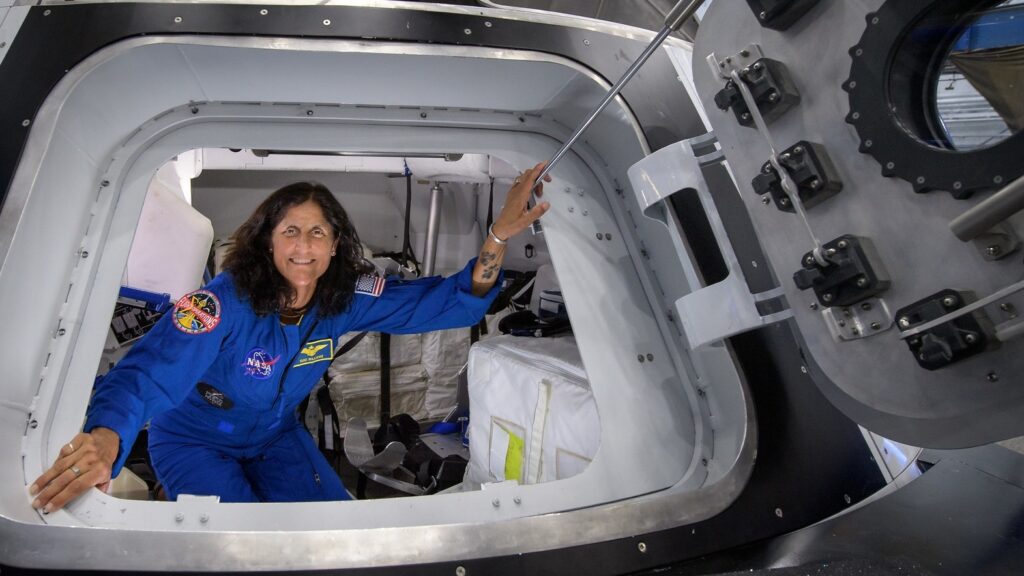
NASA astronaut Suni Williams, Crew Flight Test pilot, poses in the Boeing Mockup Trainer to simulate the Starliner spacecraft at NASA’s Johnson Space Center in Houston.
(Image credit: NASA/Bill Ingalls)
When Suni Williams was assigned to fly on board Boeing Starliner flight in 2018, no one anticipated it would be a six-year wait for launch.
The veteran NASA astronaut and former U.S. Navy test pilot spoke March 22 about the “emotional rollercoaster” the Starliner team went through in the years since, through two uncrewed test flights, the pandemic and a host of other technical issues that had to be addressed before safely launching astronauts.
The years of work in between, though intense, were a “test pilot’s dream” and are finally coming to fruition. Williams and commander Butch Wilmore are now expected to launch on the 10-day Crew Test Flight no earlier than May 6. “I don’t think I would really want to be in any other place right now,” Williams added.
Wilmore and Williams, in fact, were initially assigned to the operational and six-month-long Starliner-1 mission scheduled to fly after CFT. Many other crew swap-outs also happened in the intervening years, but everyone always had confidence in Starliner: “it’s a solid spacecraft,” Williams told reporters at a press conference here at NASA’s Johnson Space Center.
Related: 1st Boeing Starliner astronauts are ready to launch to the ISS for NASA (exclusive)
Both Boeing and Space were tasked in 2014 to bring NASA astronauts to the International Space Station (ISS) aboard commercial crew spacecraft. SpaceX has been doing so operationally since 2020, while Starliner had to wait to address numerous technical issues. (Boeing, NASA and the astronauts all stress that the relevant problems have been addressed ahead of launch day.)
While the spacecraft is certified for an astronaut test flight, the work is not over. CFT is a developmental mission, former Navy test pilot Wilmore stressed at the same press conference. This means the astronauts, their support teams and even the Starliner-1 crew (now expected to launch in 2025) are creating the training program as they’re going along. The spacecraft is also continuing to change, if slightly.
Breaking space news, the latest updates on rocket launches, skywatching events and more!
“We are sort of the trailblazers, if you will, getting those training processes in place and developing them,” Williams told reporters. And that mindset requires, he said a bit later on, looking beyond a “finish line” or setting firm dates for any mission milestone.
“We are trained in flight test, and by the good Lord’s allowing, we are now in a position for spaceflight test — which not a lot of people have had the opportunity to do. And we take that very seriously,” said Williams. “So we look at the tasks at hand, the ones that are close or that we’re dealing with at the time, (while) also always looking at the long-term mission. So the finish line is not something that I focus on.”
Related: Boeing begins fueling Starliner capsule ahead of 1st astronaut launch
Boeing’s Starliner makes its first uncrewed approach to the International Space Station during Orbital Flight Test-2 on May 21, 2022. (Image credit: NASA)
Williams said the years of extra practice have given her confidence that both Boeing and NASA have looked at the small details for their shakedown mission, including adding numerous backups for procedures and systems.
The spacecraft, for example, could run through all major procedures with no communications. The astronauts can also take over any automatic system during docking or landing to steer Starliner in the right direction, and the team is well-rehearsed on launch aborts and other critical procedures.
NASA astronauts Suni Williams (foreground) and Butch Wilmore wearing Boeing spacesuits in the Starliner spacecraft simulator at NASA’s Johnson Space Center during emergency training on Nov. 3, 2022. (Image credit: NASA/Robert Markowitz)
“I feel like we’ve invested the time” since the first uncrewed flight test that failed to see Starliner reach the ISS in 2019, Williams said; after all, Starliner made it there on its second try in 2022. The team, she said later in the conference, is “pretty sharp” because “we’ve gone through this process together.”
“We really looked into the spacecraft, and delved into everything that we could know about it, and (added) some changes on things where we thought there needed to be changes,” she added. “That’s why I think we’re ready to go, because we have been part of … that developmental process. It wasn’t quite done, and we noticed that, and we’ve worked to make sure now it’s done. It’s ready.”
With the years of training starting to close, Wilmore said he is allowing himself to think about the emotions of launch day. “I’m looking forward to walking to the pad, and the launch,” he said, adding, “It’s a great seat to be in.”
Williams added she wants to pinch herself at the prospect of her first spaceflight in a dozen years, since launching on a Russian Soyuz spacecraft in 2012. (Wilmore’s last flight was almost as long ago, in 2015.) While the crew is not quite aboard CFT yet, she said entering quarantine will make it feel more real.
“That’s sort of getting to be it, and then it’s all icing on the cake. By that time, pretty much everything’s done,” Williams said of quarantine. After launch, there’s also a familiar sight to look forward to: “I really cannot wait ’til we see space station through the window. That will be super cool.”
Join our Space Forums to keep talking space on the latest missions, night sky and more! And if you have a news tip, correction or comment, let us know at: community@space.com.
Elizabeth Howell (she/her), Ph.D., is a staff writer in the spaceflight channel since 2022 covering diversity, education and gaming as well. She was contributing writer for Space.com for 10 years before joining full-time. Elizabeth’s reporting includes multiple exclusives with the White House and Office of the Vice-President of the United States, an exclusive conversation with aspiring space tourist (and NSYNC bassist) Lance Bass, speaking several times with the International Space Station, witnessing five human spaceflight launches on two continents, flying parabolic, working inside a spacesuit, and participating in a simulated Mars mission. Her latest book, “Why Am I Taller?”, is co-written with astronaut Dave Williams. Elizabeth holds a Ph.D. and M.Sc. in Space Studies from the University of North Dakota, a Bachelor of Journalism from Canada’s Carleton University and a Bachelor of History from Canada’s Athabasca University. Elizabeth is also a post-secondary instructor in communications and science at several institutions since 2015; her experience includes developing and teaching an astronomy course at Canada’s Algonquin College (with Indigenous content as well) to more than 1,000 students since 2020. Elizabeth first got interested in space after watching the movie Apollo 13 in 1996, and still wants to be an astronaut someday. Mastodon: https://qoto.org/@howellspace
>>> Read full article>>>
Copyright for syndicated content belongs to the linked Source : Space.com – https://www.space.com/boeing-starliner-nasa-astronauts-delay-emotional-rollercoaster-launch
